Crafting Cooperative Board Games: A Masterclass in Fostering Teamwork
In the world of board games, the term ‘cooperative’ takes on a whole new meaning. It’s not about competing against each other, but rather working together towards a common goal. This shift from competitive to cooperative play is a unique challenge for game designers, but one that brings immeasurable rewards when done right. So, how do you create a board game that encourages collaboration and teamwork? Let’s delve into the fascinating realm of cooperative board game design.
The Heart of Cooperation
Cooperation is the core of these board games. It’s about players joining forces, pooling their resources, and devising strategies together to win the game. This collaborative spirit is what sets cooperative board games apart from their competitive counterparts.
As game designer Matt Leacock said, “In a cooperative game, the players win or lose as a team, which is a relatively unique concept in tabletop games.”
Designing such games requires careful thought and meticulous planning. The key is to integrate cooperative elements seamlessly into the gameplay, making teamwork not just beneficial, but necessary for victory.
Encouraging cooperation shouldn’t mean forcing it. Instead, it should emerge naturally from the game’s mechanics and objectives. A well-designed cooperative board game is one where players feel a genuine sense of camaraderie and shared purpose.
Balance: The Scale of Difficulty and Success
Maintaining a balance in cooperative games is a tricky business. On one hand, the game should be challenging enough to require teamwork. On the other hand, it shouldn’t be so hard that it becomes frustrating or impossible to win.
“Games are most fun when they are a close call,” says Leacock. “If you win all the time, the game is too easy. If you lose all the time, the game is too hard. The trick is to balance on the knife-edge between the two.”
The balance also extends to the game’s mechanics. Every player should have a unique role, with abilities that contribute to the team’s success. This ensures that all players feel valued and engaged, fostering a spirit of collaboration.
Key Mechanics for Cooperative Play
When it comes to mechanics, cooperative board games require a unique approach. The goal is to create situations where players must collaborate to succeed.
One popular mechanic is the ‘common threat.’ Here, players work together to overcome a shared challenge, such as a ticking time bomb in “Escape: The Curse of the Temple” or a spreading disease in “Pandemic.”
Another effective mechanic is ‘limited communication.’ In games like “Hanabi,” players have incomplete information and must rely on their teammates’ clues to make informed decisions.
The best cooperative games utilize a variety of mechanics to keep gameplay fresh and engaging, offering players a range of strategic options and fostering dynamic team discussions.
The Psychology of Cooperative Play
Understanding the psychology of cooperative play can be a powerful tool in a game designer’s toolkit. It’s about understanding what motivates players to cooperate and what kind of experiences they find rewarding.
“Cooperative games are a way to experience and practice teamwork in a safe and fun environment,” says Dr. Scott Rigby, a psychologist and game designer. “They can help us build empathy, improve communication, and learn to navigate conflicts in a constructive way.”
Appealing to these psychological needs can make your game more engaging and satisfying, turning a simple board game into a profound social experience.
Conclusion: Crafting a Shared Adventure
Creating a cooperative board game is more than just designing mechanics and rules. It’s about crafting a shared adventure, an experience that brings people together and strengthens bonds. It’s about fostering collaboration and teamwork, making every victory feel shared, and every loss a team effort.
As game designer Reiner Knizia puts it, “When playing a game, the goal is to win, but it is the goal that is important, not the winning.” In cooperative games, this sentiment rings particularly true. The journey becomes as important as the destination, and the shared experience is the real victory.
So, whether you’re a seasoned game designer or a novice looking to explore new territories, consider delving into the world of cooperative board games. It’s a challenging endeavor, but one that promises immense satisfaction and endless fun. After all, what could be better than creating an experience that brings people together?
FAQs
What are some popular cooperative board games?
Answer: Some popular cooperative board games include “Pandemic,” “Forbidden Island,” “Gloomhaven,” “Ghost Stories,” and “Arkham Horror.” These games are renowned for their engaging gameplay and strong emphasis on teamwork and strategy.
How do cooperative board games differ from competitive ones?
Answer: In cooperative board games, players work together towards a common goal, rather than competing against each other. The team wins or loses together, fostering a spirit of camaraderie and shared purpose.
What are some key mechanics in cooperative board games?
Answer: Some key mechanics in cooperative board games include a common threat that players must overcome together, limited communication where players have incomplete information and must rely on each other, and unique player roles that contribute to the team’s success.
How can cooperative board games be balanced?
Answer: Balancing cooperative board games involves ensuring the game is challenging enough to require teamwork, but not so hard that it becomes frustrating. Each player should also have a unique role that contributes to the team’s success.
What is the appeal of cooperative board games?
Answer: Cooperative board games offer a unique social experience. They foster teamwork and collaboration, help players build empathy and improve communication, and provide a fun and safe environment to navigate conflicts constructively.
Keywords: cooperative board games, game design, teamwork, collaboration, game mechanics, balance in games, psychology of cooperative play
Anecdote: I remember the first time I played a cooperative board game – “Forbidden Island.” The tension was high as we raced against time, pooling our resources to save the sinking island. The sense of camaraderie was palpable – it wasn’t about who won, but if we won. And when we did, it was a shared victory that brought us closer together. It was a stark contrast from the competitive games we were used to, and we found ourselves drawn to the unique challenge and social experience cooperative games offered. It was a revelation that changed how I viewed board games forever.







